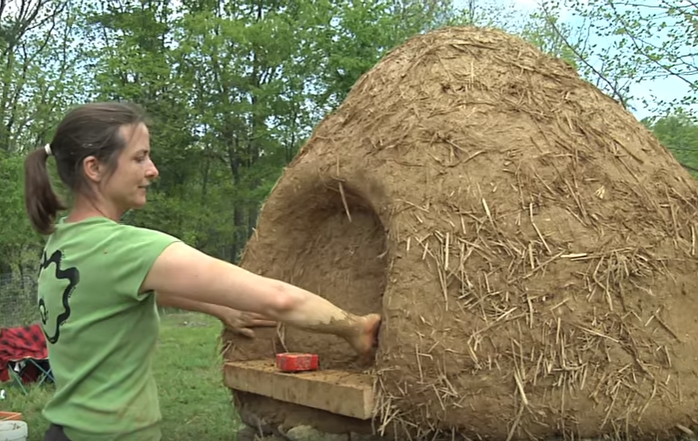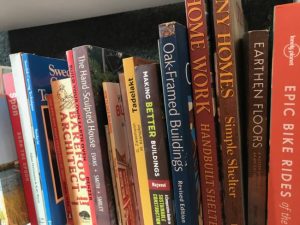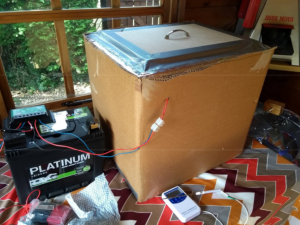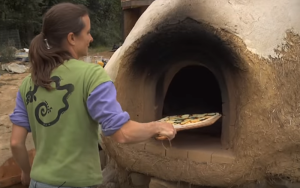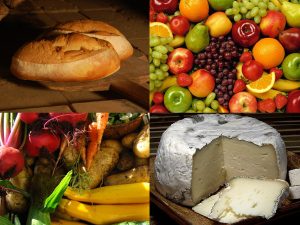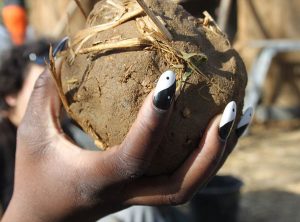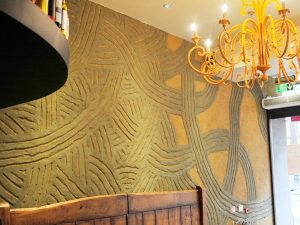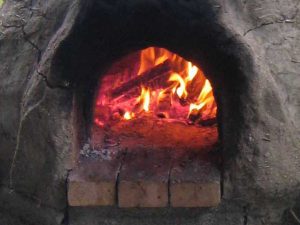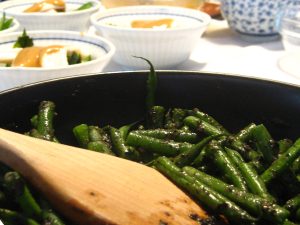Sigi Koko of Down to Earth Design shares a step-by-step building process to help you build your very own outdoor cob oven using local natural materials. Part 1 covered the preparation stages – if you missed out you can find it here.
So you’ve made the preparations and you’re ready to build your cob oven…
Step 1: Building the base

Credit: Sigi Koko
I like to make a shallow foundation filled with gravel to help keep the oven from moving with freeze-thaw cycles in the ground.

Credit: Sigi Koko
You can build your base with any masonry material – this example uses old cobblestones from the streets of Philadelphia, built with a cob (clay, sand and straw) mortar mixture.
Step 2: Fill in your base and build the oven floor

Credit: Sigi Koko
Fill in the base of the oven with a non-compressible material, like tamped gravel. Then add a 4″ or so layer of sand that extends just above the sides of your base. Tamp and level that sand.

Credit: Sigi Koko
Then build your oven floor with the firebricks, making sure they are nice and tight to each other. Tamp your bricks and make sure they are nice & level. Spend some extra time here – the nicer your oven floor, the fewer nooks and crannies that will cause you potential headaches when you are baking.
Step 3: Build the form for your oven cavity

Credit: Sigi Koko
Basically, you are building the most boring sand castle ever: a nice dome. The dome width is the diameter of baking space you want. The height of the dome will be 75% of whatever your width is.

Credit: Sigi Koko
Add a layer of newspaper over your sand so that when you dig out the sand at the end, you know when to stop digging (before gauging your clay layer).
Step 4: Build the clay mass layer of your oven

Credit: Sigi Koko
The first layer of your oven is cob without the straw, so just sand and clay. You want enough clay so the mixture is sticky, but enough sand so that this layer doesn’t shrink (and then crack) a lot. For most types of clay, that means between 20% and 25% total clay content. I like to make this layer 4″ thick, all the way around your sand dome. I do not worry about the door at this point as I can carve that out later.
Step 5: Add the insulation layer

Credit: Sigi Koko
Your insulation layer is mostly straw, with just enough clay to act like hairspray to hold the straw together. The idea is to keep the heat inside the oven for as long as possible, increasing the efficiency. What to do: use a clay mixture that is 50% clay and 50% sand (if that is the proportion in your soil, then you can just use your soil), wet the clay/sand mixture so it is quite soggy – like a chocolate milkshake – then add lots of loose straw, until all of the straw is coated with clay. Then smoosh it in place. I use about 6″ thick of insulation.
Step 6: Cut the door

Credit: Sigi Koko
I like to sculpt the door in the insulating layer. The straw has really good binding properties, which make it easy to sculpt a nice arch for your door. If you are not doing a chimney, then the height of the door needs to be 2/3 as high as the inside dome. This allows fresh oxygen-rich air to come in the bottom of your door opening to feed your fire and the exhaust exits the top of the door area without smothering the fire. If you make a door ahead of time, you can use that as your template for sculpting and cutting your opening.
Step 7: Let the oven dry for a few days, then pull out the sand

Credit: Sigi Koko
There are a few strategies for taking out the sand. I like to carve out the door the day the oven is finished, then pull out about a third of the sand, and then let the oven sit for several days to let the clay mass layer dry out a bit. Then you can pull out the remainder of the sand without risking any collapse of the dome. But don’t worry if you pull out the sand too soon and part of it collapses – you can just patch it with the same materials.
Step 8: Sculpt your oven as desired

Credit: Sigi Koko
Use clay, sand and lots of straw to make a firm, cob mixture that you can use to sculpt your oven into any shape that makes you happy. If your oven has begun to dry out when you start sculpting, be sure to wet down the surface before you add your sculpted pieces, otherwise they will not bond to what is existing. You can also put mosaic tile on your oven or plaster it with clay or lime plaster. The photo above shows a lime plaster that is fairly weather-resistant.
Step 9: Let your oven dry out completely… and then have a pizza party!

Credit: Sigi Koko
Fire the oven for 2 to 3 hours, with a nice hot fire. Then let the fire go to embers. If you made a fairly large oven, you can distribute the coals around the back perimeter of the oven to keep it hotter longer. Otherwise, pull all of the fire out (into something non-flammable, non-melt-able) and clean the oven floor with a damp cotton mop or cotton T-shirt.

Credit: Sigi Koko
Put the door on for about 20 minutes to let the temperatures come to equilibrium, and then bake pizza, bread, casseroles, cookies, pies, and anything else your heart desires. As the oven gets to around 100 degrees, you can even use it to culture yogurt. Make sure you keep a well-fitting door on the oven to keep the heat in. Happy baking!
Need more help?
Watch these videos that show you the step-by-step process for building a cob oven.
Find the original post here on Sigi Koko’s Building Naturally blog.
 About the author
About the author
Sigi Koko is the principal designer at Down to Earth Design, which she founded in 1998 to help her clients manifest their dreams of living in a natural, healthy home. She also teaches natural building workshops that empower her clients to contribute creatively during the construction of their own home. You can find out more about her work on her website and blog.

